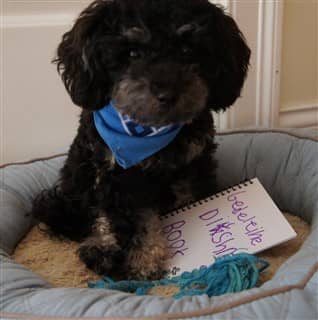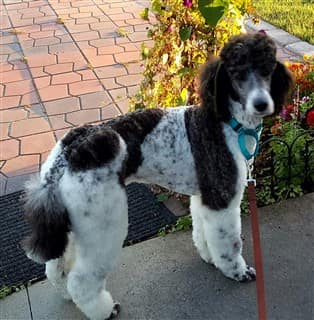Poodle Territorial Marking
Overview
If your Poodle keeps peeing in the house, this may not be a housebreaking issue, it may be a matter of territorial marking. This is not uncommon with dogs, and can be seen with just about every age (other than very young pups), and with both genders.
Since marking is a behavioral issue, it’s important to approach this from the right angle, in order to stop it.
In this section, we will cover:
- Marking vs house training accidents
- Conditions to have ruled out first
- Why Poodles mark
- Exactly how to stop a Poodle from marking
The following is relevant to all Poodles: toys, miniatures, and standards.
Please note:
AllPoodleInfo is reader-supported, and some of the product suggestions on this page are affiliate links. As an Amazon Associate we earn from qualifying purchases. This is at no extra cost to you and helps us continue providing free, high-quality information.
Marking vs Housebreaking Issue: How to Know the Difference

- The Poodle has reached maturity. Young pups rarely mark, as the drive behind the behavior is not there. Therefore, if a toy Poodle is under 4 months old, a miniature Poodle is under 6 months old, and a standard Poodle is under 9 months old, this may be too young for territorial marking.
Health Conditions to Rule Out First
Some health conditions may be mistaken for a marking problems. as they cause a dog to have limited control over their bladder. Both UTIs
(urinary tract infections) and bladder infections are common ailments that mimic marking.
With both of these, signs include frequent urination, having ‘accidents’ in the house, dribbling urine, discomfort while urinating, straining while urinating, and/or licking of the genital area.
If you suspect that this may apply to your Poodle, you’ll want to bring your Poodle to the vet for an examination.
Top Reasons Why Poodles Mark
Canines mark to claim the house as their territory. And this itself, has several causes.
It is due to one or more of the following:
- To claim dominance over other dogs. In multiple-dog homes with un-fixed dogs, marking may be done to ‘fight’ for territory.
If one Poodle marks indoors, another may mark to cover up the first dog’s scent.
- To leave a mating signal. A male that is not neutered may mark to leave his scent for females (more common if an un-spayed female is in the house or is nearby). And a female that is not spayed may mark during her heat cycle regardless of whether or not a male is nearby.
- As a response to visitors in the home. Any pet or person that has entered the house may trigger marking behavior.
If a dog has visited, the scent that is left behind can last for weeks or even months if not properly cleaned. With people, this may apply to workmen and others who only enter for a short time, or friends or family that visit quite often.
- A response to a new household member. This typically involves the addition of a new baby.
- To claim dominance in the house. Every household has a hierarchy, with a leader (Alpha) and followers (Betas). If a Poodle believes that he/she is Alpha or even thinks that gaining that title is achievable, marking may be done in an attempt to claim the role.
A Note About Peeing on an Owner’s Bed:
When a Poodle pees on an owner’s bed, their shoes, or any other personal property, it may seem like a personal insult.
However, in many cases, this is a matter of the dog feeling the heavy weight of being Alpha. With that, comes the need to protect the ‘pack’ (household members). Marking is one way to do that. A dog will leave his scent right where his owner’s scent is. It leaves a message that means, ‘Strangers beware, and do not come near my human’.
Fortunately, this can be resolved, as shown ahead.
How to Step a Poodle from Territorial Marking in 5 Steps
#1 Have Your Poodle Spayed or Neutered
There are many advantages of spaying and neutering, including greatly cutting down on the chances of developing certain cancers. And, another top reason to have this done is that it reduces a dog’s urge to mark. It can also improve other behaviors including aggression-type behavior and urges to run away.
Akkiro, at 2 months old, photo courtesy of the Basingan Family
#2 Establish Your Role as Leader
- Any other items such as toys are not given freely. A ‘Sit’ must be obey before the Poodle is given a new toy or any other object that would be considered desirable.
- You will enter and exit the house first. In the canine world, the Alpha (leader) has the privilege of entering and exiting the den (house) first. Each time you open the door and let your Poodle run out ahead, it is sending mixed messages.
- The Poodle must stay in a heeling position while being walked. This is one area that is commonly overlooked, and it’s a shame since the opportunity is there one to two times per day. If a Poodle is allowed to walk ahead of the owner, this puts the dog in charge.
However, it is you that should be in charge. And, expecting a ‘Heel’ is not as complicated as you may think.
For this, you will want your Poodle to be on a short (6 foot or adjustable leash) and a harness (not a collar, as that offers little control and can lead to neck injury).
You will have your Poodle to your left, with the leash giving no more leeway than this. As your dog walks beside you, repeat the ‘Heel’ command as you go. Randomly palm small training treats, to reinforce the heeling. Offer a final reward at the end of the walk.
As you practice with your Poodle, make the walks more challenging, with stops and turns.
- In cases with strong marking, and a general disregard for Alpha/Beta roles, a stricter approach of always being at a physically superior height than your Poodle may be needed; the dog is not allowed on their human’s bed or on any furniture that the owner is sitting on.
#3 Clean the House with an Enzyme Cleanser
When dogs mark, the urine deposits incredible strong enzyme odors. Soap and water does not remove this. There will be lingering odors that you cannot smell, but your Poodle can. And until those are cleaned, this may lead to repeated marking in those areas.

Chuchi, at 1 year old,
photo courtesy of The Franklins
You’ll want to clean all previously marked areas, and continue to clean any new marking with an effective enzyme cleanser like Sunny and Honey's Pet Stain & Odor Miracle Enzyme Cleaner .
.
This particular one properly removes all urine odors, and works on all types of flooring including tiles, hardwood, and carpeting. It's all natural, and even has a 100% guarantee.
In addition, if another dog has been in your home, even if that dog did not urinate inside, you may wish to use this sort of cleanser throughout the house.
#4 Supervision and Confinement
Poodles that are marking cannot be given free rein in the house. After all, if a Poodle keeps peeing on their owner’s bed, it makes sense that the Poodle should not be allowed on that bed. And if a Poodle keeps sneaking away to pee behind the sofa, the answer is to not allow the dog access behind the sofa.
So, how do you go about doing this?
There are two methods, which should both be used depending on if you are home or not, and your ability at any given moment to keep close tabs on your Poodle.
1) Tethering
– This is also known as the umbilical cord method. In essence, you keep your Poodle tied to you via a leash, so that your dog right by your side.
This is best done with a short leash that has a soft, roped handle (see recommended leash above) and a harness (as to not cause neck injury). The handle is slipped through your belt loop or kept over your wrist.
With your Poodle right near you, any time that you see your dog make a motion to pee, you will quickly interrupt them (with a loud hand clap and a firm ‘No!’, and bring them outside. If you must, and if you have a toy or mini that is easily carried, pick your Poodle up and bring them out.
2) Pleasant confinement
– This should be done any time that you cannot tether your Poodle to you, and confining a dog does not need to be a ‘bad’ thing that seems like punishment.
When you want to keep your Poodle in one area, but not cause stress, feelings of isolation, or claustrophobic anxiety, one of the best options is a canine playpen. These come in a range of sizes, and are best for toy Poodles, miniatures, and young standards.
These are also fantastic to use for housebreaking, for separation anxiety
(to create a feeling of a safe ‘den’ and for a Poodle to have all needed aids nearby), to limit destructive chewing.
For large standard Poodles, using gates to block off a section of a room, or a full room, is a good choice.
With the pen, be sure to have a quality bed, favorite toys, food, water, and pee pads.
Your Poodle does not need to be pee-pad trained for this. This is a defined space with bed, toys, and bowls taking up real estate, and pee pads in remaining areas. Since dogs rarely soil their own belongings, urine and bowel movements will most likely be deposited on the pads.
#5 Reinforcement of House Training Rules
The more times that a Poodle is rewarded for urinating outside, the more apt he will be to repeat the behavior.
The rules for house training
a Poodle include:
1.
Keep your Poodle tethered to you or confined.
2.
Choose 1 designated bathroom area that is easily accessible all-year round.
3.
Bring your Poodle out first thing in the morning, every couple of hours, 20 minutes after a meal, and right before bed time.
4.
Bring your Poodle to the designated area before any walks. If your let your Poodle pee along the way, this is a huge missed opportunity to teach the rules.
5.
Choose a trigger word such as 'pitty-potty' and use it each time you go out, during the deed, and when giving praise (i.e. 'Good, pitty-potty, good girl!').
6.
Always give immediate reward. The treat should not be one that your Poodle is routinely given, it should be extra delicious, and it should be properly sized (training treats need to offer quick flavor, and not be something that a Poodle sits down to chew on).
A good choice is Zuke's Mini Naturals Dog Treats , which are 100% all natural and come in duck, salmon, chicken, wild rabbit, and peanut butter.
, which are 100% all natural and come in duck, salmon, chicken, wild rabbit, and peanut butter.
7.
Clean any accidents with a quality enzyme cleanser.
Final Thoughts
Our Poodles do want to please us; in some cases, it will involve intervention and direction by you. Marking can be a frustrating behavior; however, if you are determined to stop your Poodle from peeing all over the house, you can find success by following all of the guidelines that are applicable to your dog.
If you’ve followed all of these steps to a T, and marking behavior continues, it is a good idea to have your Poodle screened for health issues. And in cases of a very defiant dog, obtaining personal one-on-one professional dog training may be in order.
You May Also Like:
Getting Rid of Tear Stains on a Poodle
- If you want those discolored hairs gone for good, these are the exact steps.
Best Toys for a Poodle
- Whether you're looking for the right chews for teething pups, or need something that helps your Poodle stay busy, these are our top picks.
Top Poodle Care Tips
- The most important aspects to take optimal care of your Poodle.



